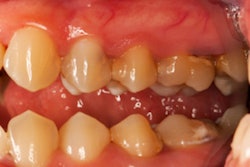
Patients with a history of periodontitis who develop head and neck squamous cell carcinoma (HNSCC) are more likely to have human papillomavirus (HPV)-positive tumors, according to researchers from the University of New York at Buffalo.
The findings could lead to the prevention and treatment of oral inflammation and also reduce the prevalence of oral HPV infection, according to the study authors (Archives of Otolaryngology -- Head & Neck Surgery, June 18, 2012).
The National Cancer Institute has reported a steady increase in the incidence of oropharyngeal cancers in the U.S. since 1973, despite a significant decline in tobacco use since 1965, they noted. Similar trends have been observed worldwide, and the increase has been primarily attributed to a parallel increase in HPV cases.
The research team, led by Mine Tezal, DDS, PhD, evaluated 124 patients with newly diagnosed primary squamous cell carcinoma of the oral cavity, oropharynx, and larynx between June 1999 and September 2007 at the Roswell Park Cancer Institute. Patients who were younger than age 21 and those with a history of cancer were excluded.
“Periodontitis ... may represent a clinical high-risk profile for oral HPV infection.”
— Mine Tezal, DDS, PhD
Periodontitis history was measured by alveolar bone loss (ABL).
Patients with HPV-positive tumors had significantly higher ABL (4.57 mm versus 3.78 mm; p = 0.001) and fewer missing teeth (7.38 versus 11.02; p = 0.02) compared with those with HPV-negative tumors, the retrospective study found.
Of the 124 patients with primary HNSCC, 31 (25%) had tumors located in the oral cavity, 49 (39.5%) in the oropharynx, and 44 (35.5%) in the larynx. Fifty (40.3%) of the 124 tumor samples were positive for HPV-16. A higher percentage of oropharyngeal cancers were HPV-positive (65.3%) compared with oral cavity (29%) and laryngeal (20.5%) cancers, the researchers noted.
They also found that each millimeter of ABL increased the odds of HPV-positive tumor status 2.6 times, after adjusting for age at diagnosis, gender, and smoking status. The remaining dental variables -- caries, fillings, missing teeth, and edentulous state -- were not significantly associated with tumor HPV status, the researchers noted.
The study findings suggest that periodontitis may be associated with the HPV status of HNSCC, especially for patients with oropharyngeal SCC compared with those with laryngeal and oral cavity SCC.
Previous research
An association between chronic inflammation and HPV infection is biologically plausible because HPV infects basal cells of the epithelium exclusively and gains access through breaks in the mucosa, Dr. Tezal noted.
In 2009, she led a similar study that found that chronic periodontitis is an independent risk factor for HNSCC (Cancer Epidemiology, Biomarkers and Prevention, September 2009, Vol. 18:9, pp. 2406-2412).
"We started to study the association between chronic inflammation and HNSCC, and along the way we noticed the interactions between different risk factors of HNSCC, including inflammation, HPV, and smoking," Dr. Tezal told DrBicuspid.com.
The validity of the association between chronic inflammation and HPV infection is supported by multiple epidemiologic and molecular studies of cervical HPV infection, she noted. For example, mucosal damage, microulcerations, and consequent epithelial proliferation mediated by inflammatory cytokines released from periodontitis sites provide an ideal environment for initial HPV infection and its persistence (Journal of the National Cancer Institute Monographs, October 2001, Vol. 2001:29, pp. 26-30). In this inflammatory environment, HPV is also shed in greater amounts, leading to increased risk of viral transmission (Journal of Periodontology, March 2005, Vol. 76:3, pp. 358-363).
"Rather than the mere presence of the virus at one time point, its persistence is critical for the development of HPV-related diseases, including cancer," Dr. Tezal explained. "Therefore, understanding the natural history of the oral HPV infection and targeting factors associated not only with its acquisition but also with its persistence will lead to more effective strategies for prevention and for treatment."
Because of the retrospective design of the current study, the researchers could not determine whether periodontitis preceded oral HPV infection. The two oral infections may have occurred concurrently, or HPV infection may have preceded periodontitis, the researchers noted.
Even so, if prospective studies in cancer-free populations confirm that chronic local inflammation plays a significant role in the natural history of oral HPV infection, the public health implications would be important, Dr. Tezal emphasized.
"Periodontitis is easy to detect and may represent a clinical high-risk profile for oral HPV infection," she said. "Prevention or treatment of sources of inflammation in the oral cavity may be a simple yet effective way to reduce the acquisition and persistence of oral HPV infection."



















